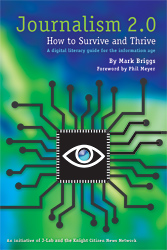Now that (most) journalists are working in digital – using audio, video, social media, blogs and databases in their reporting – how do we define whether any of it is good or not?
It’s a tough question, and one that I’ve tackled a couple of times recently at workshops and conferences, most recently at the National College Media Conference. To help me find some answers last week in Austin, I enlisted the help of some smart people from differing backgrounds:
Gary Chapman, director of The 21st Century Project at the LBJ School of Public Affairs, the graduate school of public policy at the University of Texas at Austin.
Bryan Murley, director for innovation, Center for Innovation in College Media, and assistant professor, Eastern Illinois University.
James Wickett, general manager, Community Impact Newspapers, a growing hyperlocal publisher based in Austin.
The topic is so thick and we had such limited time that I was only able to ask the panelists and handful of questions:
1. Journalists have been told for years they need to “go digital.” Many have, but in a “ready, fire, aim” manner where getting going with digital was accomplished but quality was never assessed. How does anyone know whether what they’re producing in breaking news alerts, blogs, video and other forms is good journalism?
2. Should news organizations and journalists have a sense of urgency about defining what is good in digital journalism? If so, what advice do you have for establishing this urgency?
3. What is an example of good digital journalism you have seen recently (that you can hopefully talk about with some authority)? We’ll have a projector so we can show best examples if you bring links.
All three agreed that a sense of urgency was needed in defining what’s good in digital journalism, and Chapman said it best:
“Journalists need to discover their sense of mission. Otherwise it’s just going to be a bunch of cats flushing toilets.”
Chapman also said the “continuum of information isn’t going to change” even as the methods for sending and receiving communication change rapidly. He suggested that journalists are still not using analytics as effectively as they should be and recommended more effort be focused on them.
“It’s important to split the media from the medium,” adde Wickett, whose company is print-focused with a growing digital presence. “There’s still a place for print.”
Murley came the closest to attempting a rigid definition for quality, suggesting that technical merits on multimedia and additional components to a package (timelines, maps, etc.) can help steer us toward a standard definition and a goal to shoot for.
I closed with a few minutes on how to take a practical approach back to a newsroom for standards in defining what’s good. Here’s a link to the supporting “slides” for the preso, even though it may be difficult to use by itself.
It’s a conversation every newsroom and classroom ought to be engaged in these days. Getting going with digital was the first step, but maintaining and improving quality is an equally important second step.
 Mark Briggs
Mark Briggs  Posted in
Posted in 





Flavorizer bars: They ensure excellent outcome of the grilled food and
they are porcelain-enameled. These grills function similarly to any other grill, making their ease of use and learning curve manageable for any consumer.
You might want to avoid those brands that are often listed in recalled
products.